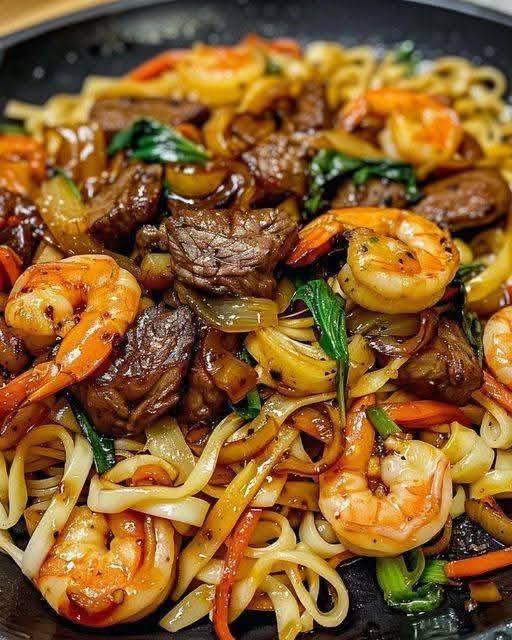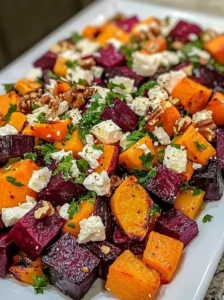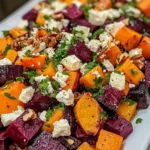Best Steak Shrimp Stir-Fried Noodles Recipe: A Flavorful Weeknight Dinner
This Best Steak Shrimp Stir-Fried Noodles Recipe delivers restaurant-quality flavors in under 35 minutes. The combination of juicy steak, plump shrimp, and chewy noodles creates a satisfying meal that beats takeout every time. Moreover, the savory soy-based sauce coats every ingredient perfectly for maximum flavor in every bite.
When you crave something hearty yet quick to prepare, this stir-fry checks all the boxes. The sizzling aroma of garlic and ginger will fill your kitchen as the steak sears to perfection. Meanwhile, the shrimp cooks just until tender, ensuring a delightful contrast of textures. Ultimately, this dish brings together protein, vegetables, and carbs in one balanced skillet meal.
Quick Recipe Highlights
- Flavor Profile: The umami-rich sauce combines soy sauce, oyster sauce, and sesame oil for depth, while garlic and ginger add aromatic warmth. A touch of sweetness balances the savory elements perfectly.
- Texture: Tender steak and shrimp contrast beautifully with the slightly chewy noodles. Crisp vegetables add freshness and crunch to each forkful.
- Aroma: Toasted sesame oil and fresh garlic create an irresistible fragrance that builds anticipation before the first bite.
- Visual Appeal: Vibrant vegetables, golden-brown steak, and pink shrimp make this dish as beautiful as it is delicious.
- Skill Level Needed: Basic knife skills and stir-fry technique will yield excellent results, making this accessible for home cooks.
- Special Equipment: A large wok or skillet and tongs make cooking easier, though any large pan will work.
Recipe Overview
- Difficulty Level: While not complicated, this recipe requires multitasking as you cook different components. Timing matters for perfect doneness of both proteins.
- Category: This versatile dish works as a main course for lunch or dinner. It also makes excellent leftovers for meal prep.
- Cuisine: Inspired by Asian stir-fry traditions, this recipe adapts techniques from Chinese and Thai cooking methods.
- Cost: Using flank steak instead of premium cuts keeps costs reasonable while delivering great flavor.
- Season: Fresh vegetables make this ideal for summer, but the comforting warmth suits colder months too.
- Occasion: Quick enough for weeknights yet impressive for casual entertaining with friends.
Why You’ll Love This Recipe
The Best Steak Shrimp Stir-Fried Noodles Recipe satisfies cravings for something hearty and flavorful without requiring hours in the kitchen. First, the combination of two premium proteins creates a luxurious feel. Second, the sauce comes together quickly from pantry staples you likely already have. Third, you can customize the vegetable mix based on what’s fresh or available.
Nutritionally, this dish provides balanced macros with protein from the steak and shrimp, complex carbs from the noodles, and vitamins from the vegetables. Furthermore, controlling the oil and sodium makes this healthier than restaurant versions. The high protein content also helps keep you full longer after eating.
For entertaining, this recipe scales easily to feed a crowd. Guests will appreciate the beautiful presentation and restaurant-quality taste. Additionally, most components can prepped ahead, reducing last-minute work when serving company.
Cost-wise, this meal delivers big flavor without breaking the bank. Flank steak offers great value, and shrimp prices often drop when bought frozen in bulk. Ultimately, you get a special occasion meal at a fraction of dining out costs.
The versatility makes this recipe a keeper. You can swap vegetables based on seasonality or preference. Likewise, adjusting the spice level or sauce ingredients lets you tailor it to your taste. This adaptability ensures the dish never gets boring no matter how often you make it.
Historical Background and Cultural Significance
Stir-frying originated in China over 1,500 years ago as a quick cooking method that conserved fuel. The technique spread throughout Asia, evolving regional variations. Noodle stir-fries became street food staples because they cooked fast and used affordable ingredients. Today, versions appear across Chinese, Thai, and Vietnamese cuisines with local adaptations.
Combining seafood and meat in one dish reflects coastal culinary traditions where fresh shrimp supplemented land-based proteins. In southern Chinese cuisine, this surf-and-turf approach appears in celebratory banquet dishes. The luxurious combination symbolized prosperity and abundance during festivals.
Western adaptations of stir-fry emerged as Asian immigrants shared their cooking methods. American versions often use more meat and sweeter sauces than traditional preparations. The addition of steak reflects the influence of Western ingredients on Asian-American cuisine.
Modern fusion cuisine continues reinventing stir-fry concepts. Chefs experiment with global flavors while preserving the quick-cooking technique. This recipe bridges traditions by honoring stir-fry fundamentals while using accessible ingredients for home cooks.
Ingredient Deep Dive
Flank steak works perfectly in stir-fries because it takes well to quick cooking. When sliced thinly against the grain, this affordable cut becomes tender and flavorful. Look for bright red meat with fine grain and minimal connective tissue. For best results, chill the steak briefly before slicing to get cleaner cuts.
Medium shrimp (31-40 count) offer the ideal size for stir-frying – large enough to stay juicy but small enough to cook quickly. Fresh or frozen both work well; just pat thawed shrimp dry to prevent steaming. Leaving the tails on adds flavor during cooking but remove them if preferred for easier eating.
Fresh egg noodles have superior texture to dried for stir-fries. Look for them in the refrigerated section of Asian markets. If unavailable, dried lo mein noodles make a good substitute. Cook them slightly firmer than package directions since they’ll finish cooking in the wok.
The sauce combination creates layered umami flavor. Soy sauce provides saltiness, oyster sauce adds depth, and sesame oil contributes nutty aroma. Adjust ratios to taste – more oyster sauce for sweetness or extra soy for saltiness. Fresh garlic and ginger are essential for authentic flavor, so avoid powdered substitutes.
Common Mistakes to Avoid
- Overcrowding the pan causes steaming instead of searing. Cook proteins in batches for proper browning.
- Underseasoning the sauce makes the dish taste flat. Taste and adjust seasoning before adding to the stir-fry.
- Overcooking shrimp turns them rubbery. Remove them as soon as they turn opaque and curl slightly.
- Using the wrong noodle type results in mushy texture. Choose noodles specifically meant for stir-frying.
- Not prepping all ingredients before cooking leads to rushed execution. Stir-frying happens fast.
- Skipping the cornstarch marinade on the steak reduces tenderness. This step matters for juicy meat.
- Adding sauce too early makes the noodles soggy. Toss everything together briefly at the end.
- Using low heat prevents proper searing. A hot wok creates the characteristic wok hei flavor.
Essential Techniques
Proper slicing ensures tender steak. Always cut flank steak thinly against the grain to shorten muscle fibers. Angle your knife about 45 degrees for wider slices that stay juicy. A sharp knife makes this easier and safer.
Velveting the steak with cornstarch creates a protective coating that locks in moisture. This Chinese restaurant technique prevents toughness during high-heat cooking. Let the coated steak sit 10 minutes before cooking for best results.
Stir-frying requires constant movement. Use a flipping motion with your wrist to toss ingredients, not just stir them. This ensures even cooking and prevents burning. Keep ingredients moving almost constantly once they hit the hot wok.
Layering flavors builds complexity. Start with aromatics like garlic and ginger to infuse the oil. Then add proteins, followed by vegetables that need less cooking. Finally, incorporate the sauce and noodles for cohesive flavor.
Pro Tips for Perfect Steak Shrimp Stir-Fried Noodles
- Pat shrimp thoroughly dry before cooking to ensure proper searing rather than steaming.
- Use a neutral oil with high smoke point like peanut or vegetable oil for stir-frying.
- Cook noodles al dente since they’ll soften further when tossed with sauce.
- Let the wok get smoking hot before adding oil to prevent sticking.
- Prep all ingredients before heating the wok because cooking happens quickly.
- Reserve some green onions for garnish to add fresh flavor and color at the end.
- Toast sesame seeds lightly before sprinkling for enhanced nutty flavor.
- Serve immediately for best texture – stir-fries don’t hold well for long periods.
Variations and Adaptations
For a spicier version, add chili garlic paste or red pepper flakes to the sauce. Thai bird’s eye chilies provide authentic heat if you enjoy fiery food. Alternatively, serve with sriracha on the side for customizable spice levels.
Vegetable variations keep the dish interesting. Try snap peas, baby corn, water chestnuts, or mushrooms for different textures. Leafy greens like bok choy or spinach add freshness when tossed in at the end.
Gluten-free adaptations work well with tamari instead of soy sauce and rice noodles. Ensure your oyster sauce is gluten-free or substitute with hoisin sauce. Cornstarch works fine for velveting the steak in this version.
For a lighter option, use zucchini noodles or shirataki noodles and reduce the sauce quantity. Increase the vegetable ratio and use leaner cuts like sirloin tip steak. This creates a lower-carb, higher-protein meal.
Serving and Presentation Guide
Traditional Chinese presentation would mound the noodles in the center with proteins and vegetables arranged around them. For family-style service, transfer everything to a large platter with garnishes on top. Individual bowls work well for casual meals.
Garnishes elevate both flavor and appearance. Toasted sesame seeds, sliced green onions, and cilantro leaves add color contrast. Lime wedges provide brightness, while chili oil offers visual appeal and optional heat.
Serve with traditional accompaniments like hot tea or light lager beer. A simple cucumber salad balances the rich flavors. For authentic style, provide chopsticks and small bowls for sharing.
Temperature matters – serve immediately while piping hot. Pre-warm serving dishes if possible. The noodles continue absorbing sauce as they sit, so timing affects final texture.
Wine and Beverage Pairing
Off-dry Riesling complements the dish beautifully with its balance of sweetness and acidity. The slight sweetness mirrors the sauce while the acidity cuts through richness. German or Alsatian versions work particularly well.
For red wine lovers, a fruity Beaujolais or Pinot Noir provides enough acidity without overwhelming the shrimp. Avoid heavily tannic reds that could clash with the seafood elements.
Asian beers like Tsingtao or Sapporo make classic pairings. Their crispness refreshes the palate between bites. Light lagers work similarly if those aren’t available.
Non-alcoholic options include jasmine tea or sparkling water with lime. The floral notes in jasmine tea enhance the dish’s aromatics. Iced green tea also makes a refreshing accompaniment.
Storage and Shelf Life
Refrigerate leftovers in airtight containers for up to 3 days. The noodles may absorb more sauce over time, so add a splash of water when reheating. Store shrimp and steak together with vegetables to maintain flavor balance.
For best texture, reheat gently in a skillet with a little oil rather than microwaving. This helps revive the noodles’ texture. Stir frequently to distribute heat evenly and prevent drying out.
Freezing isn’t recommended as the noodles and shrimp suffer texturally. The steak may become tough upon thawing. This dish truly shines when fresh.
If meal prepping, store components separately and combine when ready to eat. Cooked proteins keep 3-4 days, while noodles stay fresh 2-3 days when tossed with a little oil to prevent sticking.
Make Ahead Strategies
Prep vegetables up to 2 days in advance – slice peppers, shred carrots, and chop aromatics. Store them separately in airtight containers. Green onions stay freshest wrapped in damp paper towels.
Velvet the steak and marinate shrimp the morning of cooking. Both benefit from at least 30 minutes in their respective coatings. This step adds flavor while tenderizing the proteins.
Cook noodles 1-2 hours ahead and toss with a teaspoon of oil to prevent clumping. Spread them on a tray to cool completely before refrigerating. Bring to room temperature before stir-frying.
Mix the sauce ingredients in advance and refrigerate. Stir well before using as some separation may occur. Having everything prepped makes the actual cooking process much smoother.
Scaling Instructions
For smaller batches, halve all ingredients precisely. Use a medium skillet instead of a wok to maintain proper heat distribution. Cooking times may decrease slightly with less volume.
When doubling the recipe, cook proteins in three batches instead of two to prevent overcrowding. Increase sauce ingredients by 1.5 times initially, then adjust to taste as noodles vary in absorption.
For large gatherings, consider setting up a stir-fry station where guests can customize their bowls. Prepare all components separately and cook in small batches throughout the event.
Equipment matters when scaling up – a commercial-style wok works best for large quantities. If using a regular skillet, cook in multiple batches and keep finished portions warm in a low oven.
Nutritional Deep Dive
This balanced meal provides approximately 550-600 calories per serving with 35g protein, 60g carbs, and 20g fat. The exact values depend on specific ingredient brands and quantities used.
Shrimp contribute lean protein and selenium, while steak provides iron and B vitamins. Together they create a complete amino acid profile. Vegetables add fiber, vitamins A and C, and various phytonutrients.
Using whole wheat or high-fiber noodles increases the dish’s nutritional value. Similarly, loading up on vegetables boosts micronutrients without adding many calories. The sauce contributes most of the sodium, so adjust to dietary needs.
For weight management, watch portion sizes of noodles and increase vegetable ratios. The high protein content promotes satiety, helping control overall calorie intake at the meal.
Dietary Adaptations
Gluten-free version: Substitute tamari for soy sauce and verify oyster sauce is gluten-free. Use rice noodles or gluten-free egg noodles. Cornstarch works fine for velveting the steak in this adaptation.
Dairy-free needs no modifications as the recipe contains no dairy products. Always check labels on pre-made sauces as some may contain traces of dairy.
For vegan preparation, replace steak with extra-firm tofu or seitan and use mushrooms instead of shrimp. Substitute vegetarian oyster sauce and increase umami with a dash of MSG or nutritional yeast.
Low-carb alternatives include using zucchini noodles or shirataki noodles. Reduce the sauce quantity and increase non-starchy vegetables. Focus on the protein components for satiety.
Troubleshooting Guide
If noodles stick together, they may have been overcooked initially or not tossed with enough oil after boiling. To salvage, rinse briefly with warm water to separate strands before adding to the wok.
When sauce tastes too salty, balance with a squeeze of lime juice or sprinkle of sugar. If too sweet, add more soy sauce or a splash of rice vinegar. Adjust gradually until flavors harmonize.
For tough steak, ensure you sliced against the grain and didn’t overcook. Next time, velvet the meat longer or try a more tender cut like sirloin. For now, slice cooked steak thinner to improve texture.
If vegetables turn soggy, they may have been added too early or crowded in the pan. In the future, cook them in batches and add at the last minute. For current dish, serve with extra crunch from garnishes.
Frequently Asked Questions
Can I use frozen shrimp? Yes, just thaw completely and pat very dry before cooking. Frozen shrimp often work better than “fresh” shrimp that’s actually previously frozen and thawed at the store.
What noodle alternatives work? Rice noodles, udon, or even spaghetti in a pinch. Adjust cooking times based on the noodle type’s package directions.
How do I prevent everything from sticking? Ensure your wok is hot before adding oil, and don’t skimp on oil quantity. Also, keep ingredients moving constantly during cooking.
Can I make this vegetarian? Absolutely. Substitute tofu or tempeh for the steak and mushrooms for shrimp. Use vegetarian oyster sauce.
What’s the best cut of steak? Flank steak works great for its flavor and affordability. Skirt or hanger steak also work well when sliced properly.
How spicy is this recipe? As written, it’s mild. Add chili paste, fresh chilies, or red pepper flakes to taste if you prefer heat.
Can I prep components ahead? Yes, chop vegetables and mix sauce a day ahead. Cook noodles a few hours early. Proteins are best cooked fresh.
What if I don’t have a wok? A large cast iron or stainless steel skillet works fine. Just ensure it’s large enough to allow proper tossing space.
How do I know when shrimp are done? They turn opaque and form a loose “C” shape. Remove immediately at this point to prevent overcooking.
Why velvet the steak? The cornstarch coating helps retain moisture during high-heat cooking, preventing toughness in lean cuts.
Additional Resources
For more stir-fry inspiration, explore our collection of Asian-inspired recipes. We particularly recommend our Garlic Beef and Broccoli Stir Fry or Spicy Basil Chicken variations. Each offers different flavor profiles using similar techniques.
Mastering basic knife skills will elevate all your cooking, especially stir-fries. Practice the claw grip for safety and consistent slicing. A sharp chef’s knife makes prep work faster and more enjoyable.
Consider investing in a carbon steel wok if you make stir-fries regularly. Proper seasoning creates a natural non-stick surface. We have a complete guide to selecting and caring for woks to help you choose.
Explore our sauce variations for customizing future stir-fry creations. From black bean to Szechuan peppercorn, different sauce bases can transform the same ingredients into entirely new dishes.
PrintBest Steak Shrimp Stir-Fried Noodles
Description
A delicious and savory stir-fry dish combining tender steak, succulent shrimp, and perfectly cooked noodles with a rich umami flavor.
Ingredients
For the Crust:
- 8 oz flank steak, thinly sliced
- 8 oz large shrimp, peeled and deveined
- 8 oz fresh egg noodles
- 2 tbsp soy sauce
- 1 tbsp oyster sauce
- 1 tbsp hoisin sauce
- 1 tbsp sesame oil
- 2 cloves garlic, minced
- 1 tbsp ginger, grated
- 1 bell pepper, sliced
- 1 cup broccoli florets
- 2 green onions, sliced
- 1 tbsp vegetable oil
- 1 tsp red pepper flakes (optional)
Instructions
1. Prepare the Crust:
- Cook the egg noodles according to package instructions, drain, and set aside.
- Heat vegetable oil in a large wok or skillet over high heat. Add steak and shrimp, stir-frying until just cooked through, about 3-4 minutes. Remove and set aside.
- In the same wok, add garlic, ginger, bell pepper, and broccoli. Stir-fry for 2-3 minutes until vegetables are tender-crisp.
- Return the steak and shrimp to the wok. Add cooked noodles, soy sauce, oyster sauce, hoisin sauce, and sesame oil. Toss everything together until well combined and heated through.
- Garnish with sliced green onions and red pepper flakes if desired. Serve immediately.
Notes
You can customize the seasonings to taste.









